The Applicability of the Geostationary Ocean Color Imager to the Mapping of Sea Surface Salinity in the East China Sea
Abstract
:1. Introduction
2. Data and Methodology
2.1. In Situ Measurements
2.2. Satellite Images
3. Results and Discussion
3.1. Algorithm Development and Validation
3.2. Temporal Variations
3.3. Interaction with a Typhoon
4. Conclusions
- (1)
- The LSW retrieval algorithm empirically developed in this study using GOCI Rrs bands 3–6 was considered reliable following a comparison with both in situ measurements and the results of two previous models used to derive SSS in the East China Sea. However, further study is needed to determine whether the algorithm is applicable to high salinity waters with samples from the study area when it is not affected by the Changjiang Diluted Water, which would enable the development of a standard algorithm for satellite-derived SSS.
- (2)
- According to a time series of GOCI-derived SSS images on a diurnal and daily scale, the LSW along the east coast of China and to the north of the Changjiang River mouth extended to the northeast and influenced the southwestern part of the Korean Peninsula to the north of Jeju Island in August 2018. We found that the LSW split to the north and south near the western part of Jeju Island, extending to the Straits of Korea in the north and to the Ieodo Ocean Research Station in the south.
- (3)
- The variation of the satellite-derived SSS, CHL, and SST when Typhoon Soulik passed over the study area revealed that ocean cooling and decreasing salinity effects were strongly exhibited two days after the typhoon passed, and then became weaker a week after the passage. We also identified an increase in the CHL due to the upwelling in the study area resulting from the passage of Typhoon Soulik.
Author Contributions
Funding
Conflicts of Interest
References
- Moon, J.H.; Hirose, N.; Yoon, J.H.; Pang, I.C. Offshore Detachment Process of the low-salinity water around Changjiang Bank in the East China Sea. J. Phys. Oceanogr. 2010, 40, 1035–1053. [Google Scholar] [CrossRef]
- Ahn, Y.H.; Shanmugam, P.; Moon, J.E.; Ryu, J.H. Satellite remote sensing of a low-salinity water plume in the East China Sea. Ann. Geophys. 2008, 26, 2019–2035. [Google Scholar] [CrossRef] [Green Version]
- Kim, H.C.; Yamaguchi, H.; Yoo, S.; Zhu, J.; Okamura, K.; Kiyomoto, Y.; Tanaka, K.; Kim, S.W.; Park, T.; Oh, I.; et al. Distribution of Changjiang Diluted Water detected by satellite chlorophyll-a and its interannual variation during 1998–2007. J. Oceanogr. 2009, 65, 129–135. [Google Scholar] [CrossRef]
- Kim, D.W.; Park, Y.J.; Jeong, J.Y.; Jo, Y.H. Estimation of Hourly Sea Surface Salinity in the East China Sea Using Geostationary Ocean Color Imager Measurements. Remote Sens. 2020, 12, 755. [Google Scholar] [CrossRef] [Green Version]
- Ciani, D.; Santoleri, R.; Liberti, G.L.; Prigent, C.; Donlon, C.; Nardelli, B.B. Copernicus Imaging Microwave Radiometer (CIMR) Benefits for the Copernicus Level 4 Sea-Surface Salinity Processing Chain. Remote Sens. 2019, 11, 1818. [Google Scholar] [CrossRef] [Green Version]
- Droghei, R.; Nardelli, B.B.; Santoleri, R. A New Global Sea Surface Salinity and Density Dataset from Multivariate Observations (1993–2016). Front. Mar. Sci. 2018, 5, 84. [Google Scholar] [CrossRef] [Green Version]
- Soldo, Y.; Khazaal, A.; Cabot, F.; Kerr, Y.H. An RFI Index to Quantify the Contamination of SMOS Data by Radio-Frequency Interference. IEEE J. Sel. Top. Appl. Earth Obs. Remote Sens. 2016, 9, 1577–1589. [Google Scholar] [CrossRef]
- Mohammed, P.N.; Aksoy, M.; Piepmeier, J.R.; Johnson, J.T.; Bringer, A. SMAP L-Band Microwave Radiometer: RFI Mitigation Prelaunch Analysis and First Year On-Orbit Observations. IEEE Trans. Geosci. Remote Sens. 2016, 54, 6035–6047. [Google Scholar] [CrossRef]
- Soldo, Y.; Le Vine, D.M.; de Matthaeis, P.; Richaume, P. L-Band RFI Detected by SMOS and Aquarius. IEEE Trans. Geosci. Remote Sens. 2017, 55, 4220–4235. [Google Scholar] [CrossRef]
- Son, Y.B.; Gardner, W.D.; Richardson, M.J.; Ishizaka, J.; Ryu, J.H.; Kim, S.H.; Lee, S.H. Tracing offshore low-salinity plumes in the Northeastern Gulf of Mexico during the summer season by use of multispectral remote-sensing data. J. Oceanogr. 2012, 68, 743–760. [Google Scholar] [CrossRef]
- Qing, S.; Zhang, J.; Cui, T.W.; Bao, Y.H. Retrieval of sea surface salinity with MERIS and MODIS data in the Bohai Sea. Remote Sens. Environ. 2013, 136, 117–125. [Google Scholar] [CrossRef]
- Palacios, S.L.; Peterson, T.D.; Kudela, R.M. Development of synthetic salinity from remote sensing for the Columbia River plume. J. Geophys. Res. Oceans 2009, 114. [Google Scholar] [CrossRef] [Green Version]
- Marghany, M.; Hashim, M. A numerical method for retrieving sea surface salinity from MODIS satellite data. Int. J. Phys. Sci. 2011, 6, 3116–3125. [Google Scholar]
- Bai, Y.; Pan, D.L.; Cai, W.J.; He, X.Q.; Wang, D.F.; Tao, B.Y.; Zhu, Q.K. Remote sensing of salinity from satellite-derived CDOM in the Changjiang River dominated East China Sea. J. Geophys. Res. Oceans 2013, 118, 227–243. [Google Scholar] [CrossRef]
- Ferrari, G.M.; Dowell, M.D. CDOM absorption characteristics with relation to fluorescence and salinity in coastal areas of the southern Baltic Sea. Estuar. Coast. Shelf Sci. 1998, 47, 91–105. [Google Scholar] [CrossRef]
- Sasaki, H.; Siswanto, E.; Nishiuchi, K.; Tanaka, K.; Hasegawa, T.; Ishizaka, J. Mapping the low salinity Changjiang Diluted Water using satellite-retrieved colored dissolved organic matter (CDOM) in the East China Sea during high river flow season. Geophys. Res. Lett. 2008, 35. [Google Scholar] [CrossRef]
- Siegel, D.A.; Maritorena, S.; Nelson, N.B.; Behrenfeld, M.J.; McClain, C.R. Colored dissolved organic matter and its influence on the satellite-based characterization of the ocean biosphere. Geophys. Res. Lett. 2005, 32. [Google Scholar] [CrossRef] [Green Version]
- Liu, R.J.; Zhang, J.; Yao, H.Y.; Cui, T.W.; Wang, N.; Zhang, Y.; Wu, L.J.; An, J.B. Hourly changes in sea surface salinity in coastal waters recorded by Geostationary Ocean Color Imager. Estuar. Coast. Shelf Sci. 2017, 196, 227–236. [Google Scholar] [CrossRef]
- Moh, T.; Cho, J.H.; Jung, S.K.; Kim, S.H.; Son, Y.B. Monitoring of the Changjiang River Plume in the East China Sea using a Wave Glider. J. Coast. Res. 2018, 85, 26–30. [Google Scholar] [CrossRef]
- Choi, J.-K.; Park, Y.J.; Ahn, J.H.; Lim, H.-S.; Eom, J.; Ryu, J.-H. GOCI, the world’s first geostationary ocean color observation satellite, for the monitoring of temporal variability in coastal water turbidity. J Geophys. Res. Oceans 2012, 117. [Google Scholar] [CrossRef]
- NIFS NIFS Serial Oceanographic Observation. 2020. Available online: http://www.nifs.go.kr/kodc/eng/eng_soo_list.kodc (accessed on 22 January 2021).
- Moon, J.-E.; Park, Y.-J.; Ryu, J.-H.; Choi, J.-K.; Ahn, J.-H.; Min, J.-E.; Son, Y.-B.; Lee, S.-J.; Han, H.-J.; Ahn, Y.-H. Initial validation of GOCI water products against in situ data collected around Korean peninsula for 2010–2011. Ocean Sci. J. 2012, 47, 261–277. [Google Scholar] [CrossRef]
- Choi, J.K.; Park, Y.J.; Lee, B.R.; Eom, J.; Moon, J.E.; Ryu, J.H. Application of the Geostationary Ocean Color Imager (GOCI) to mapping the temporal dynamics of coastal water turbidity. Remote Sens. Environ. 2014, 146, 24–35. [Google Scholar] [CrossRef]
- Kim, W.; Moon, J.E.; Park, Y.J.; Ishizaka, J. Evaluation of chlorophyll retrievals from Geostationary Ocean Color Imager (GOCI) for the North-East Asian region. Remote Sens. Environ. 2016, 184, 482–495. [Google Scholar] [CrossRef]
- Son, Y.B.; Park, G.; Ryu, J.-H.; Choi, J.-K. Algorithm for low-salinity plume in the East China Sea during the summer season using two-step empirical approach for GOCI and MODIS satellite sensors. In Proceedings of the Ocean Optics XXIV, Dubrovnik, Croatia, 7–12 October 2018; The Oceanography Society: Dubrovnik, Croatia, 2018. [Google Scholar]
- Moon, J.H.; Kim, T.; Son, Y.B.; Hong, J.S.; Lee, J.H.; Chang, P.H.; Kim, S.K. Contribution of low-salinity water to sea surface warming of the East China Sea in the summer of 2016. Prog. Oceanogr. 2019, 175, 68–80. [Google Scholar] [CrossRef]
- Lee, S.; Park, M.S.; Kwon, M.; Kim, Y.H.; Park, Y.G. Two major modes of East Asian marine heatwaves. Environ. Res. Lett. 2020, 15, 074008. [Google Scholar] [CrossRef]
- Park, J.H.; Yeo, D.E.; Lee, K.; Lee, H.; Lee, S.W.; Noh, S.; Kim, S.; Shin, J.; Choi, Y.; Nam, S. Rapid Decay of Slowly Moving Typhoon Soulik (2018) due to Interactions with the Strongly Stratified Northern East China Sea. Geophys. Res. Lett. 2019, 46, 14595–14603. [Google Scholar] [CrossRef] [Green Version]
- Reul, N.; Chapron, B.; Grodsky, S.A.; Guimbard, S.; Kudryavtsev, V.; Foltz, G.R.; Balaguru, K. Satellite Observations of the Sea Surface Salinity Response to Tropical Cyclones. Geophys. Res. Lett. 2021, 48, e2020GL091478. [Google Scholar] [CrossRef]
- Park, M.S.; Elsberry, R.L. Latent Heating and Cooling Rates in Developing and Nondeveloping Tropical Disturbances during TCS-08: TRMM PR versus ELDORA Retrievals. J. Atmos. Sci. 2013, 70, 15–35. [Google Scholar] [CrossRef] [Green Version]
- Subrahmanyam, B.; Rao, K.H.; Rao, N.S.; Murty, V.S.N.; Sharp, R.J. Influence of a tropical cyclone on Chlorophyll-a Concentration in the Arabian Sea. Geophys. Res. Lett. 2002, 29. [Google Scholar] [CrossRef]
- Lee, Z.; Shang, S.L.; Lin, G.; Chen, J.; Doxaran, D. On the modeling of hyperspectral remote-sensing reflectance of high-sediment-load waters in the visible to shortwave-infrared domain. Appl. Opt. 2016, 55, 1738–1750. [Google Scholar] [CrossRef]
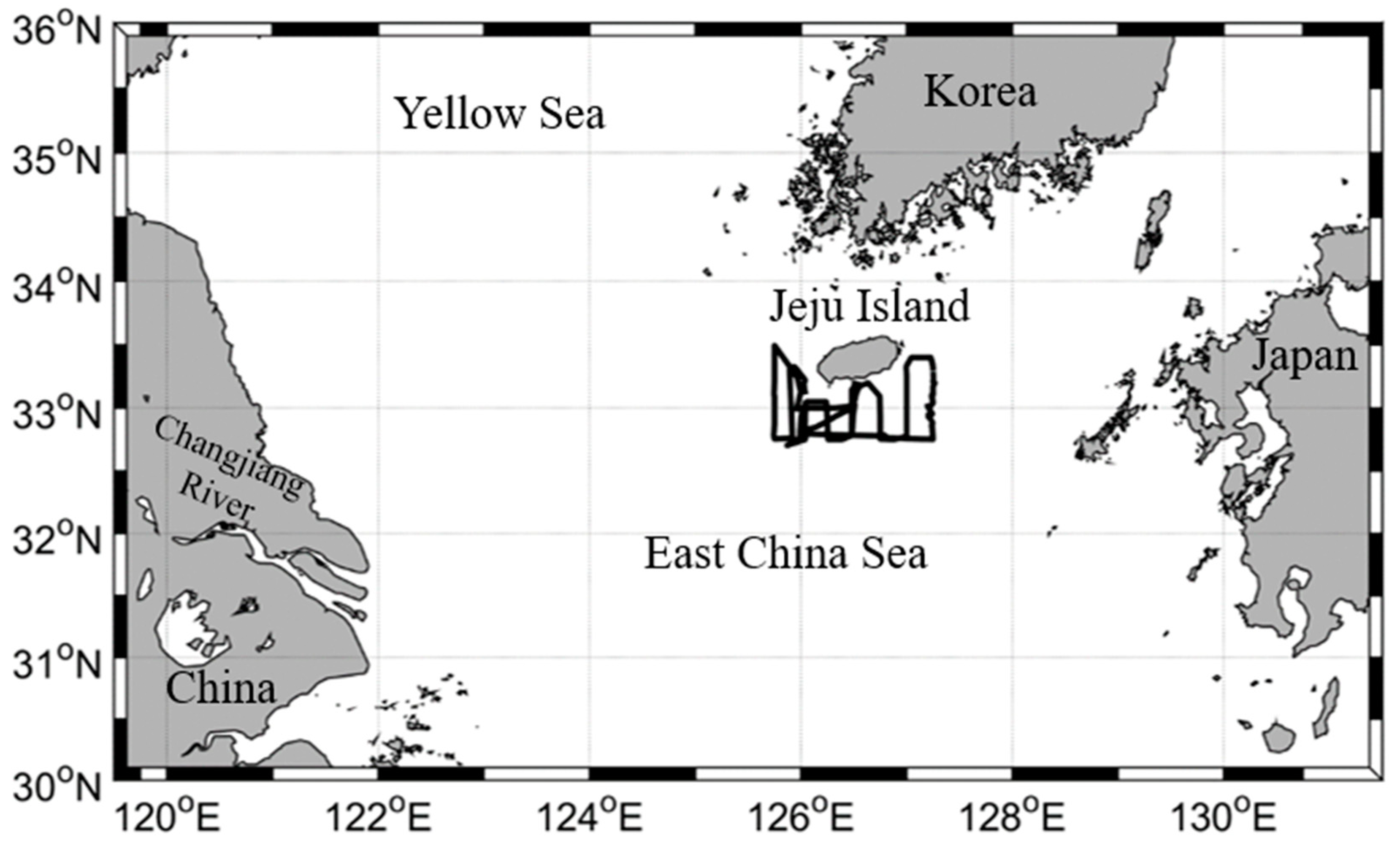


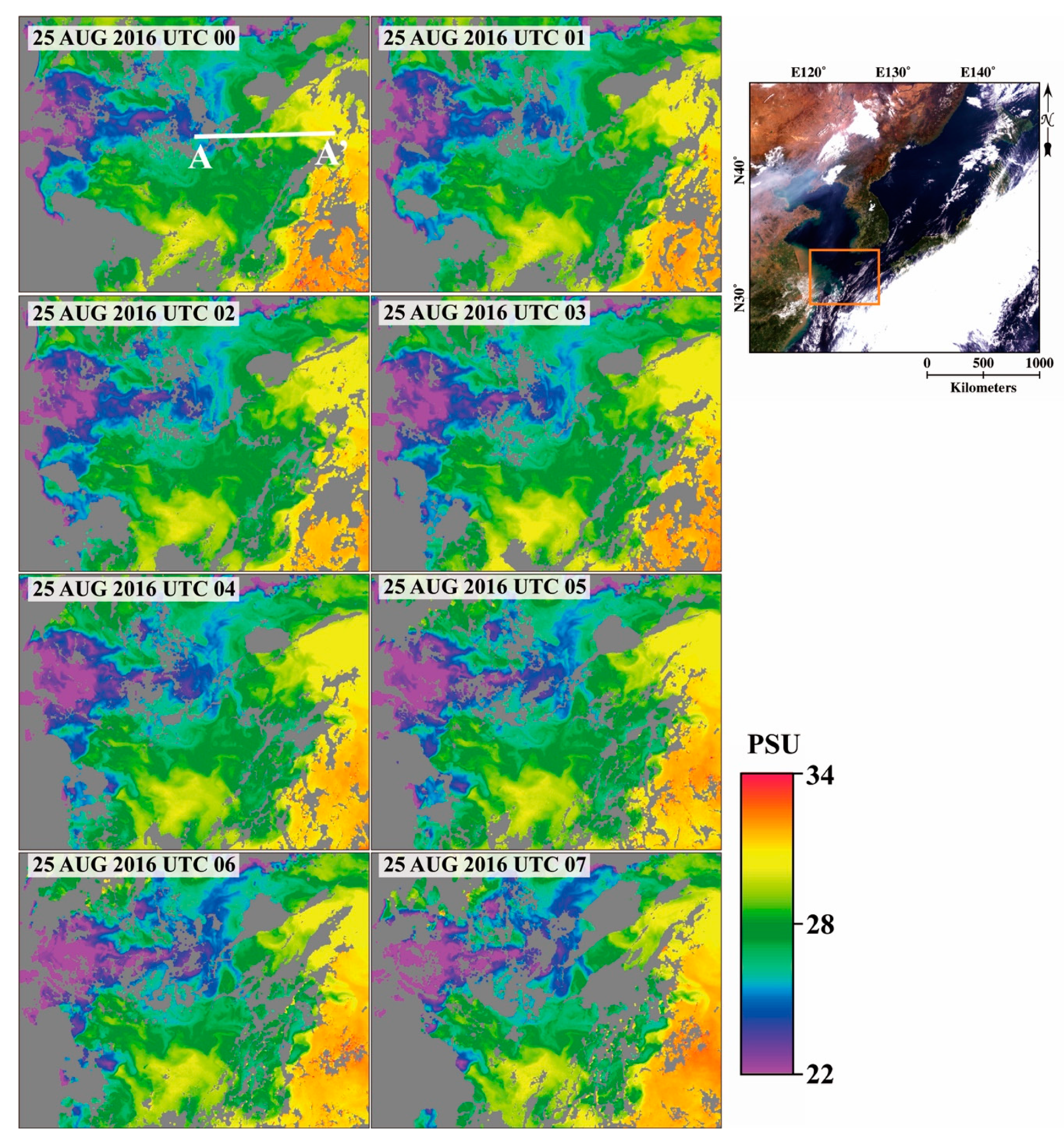
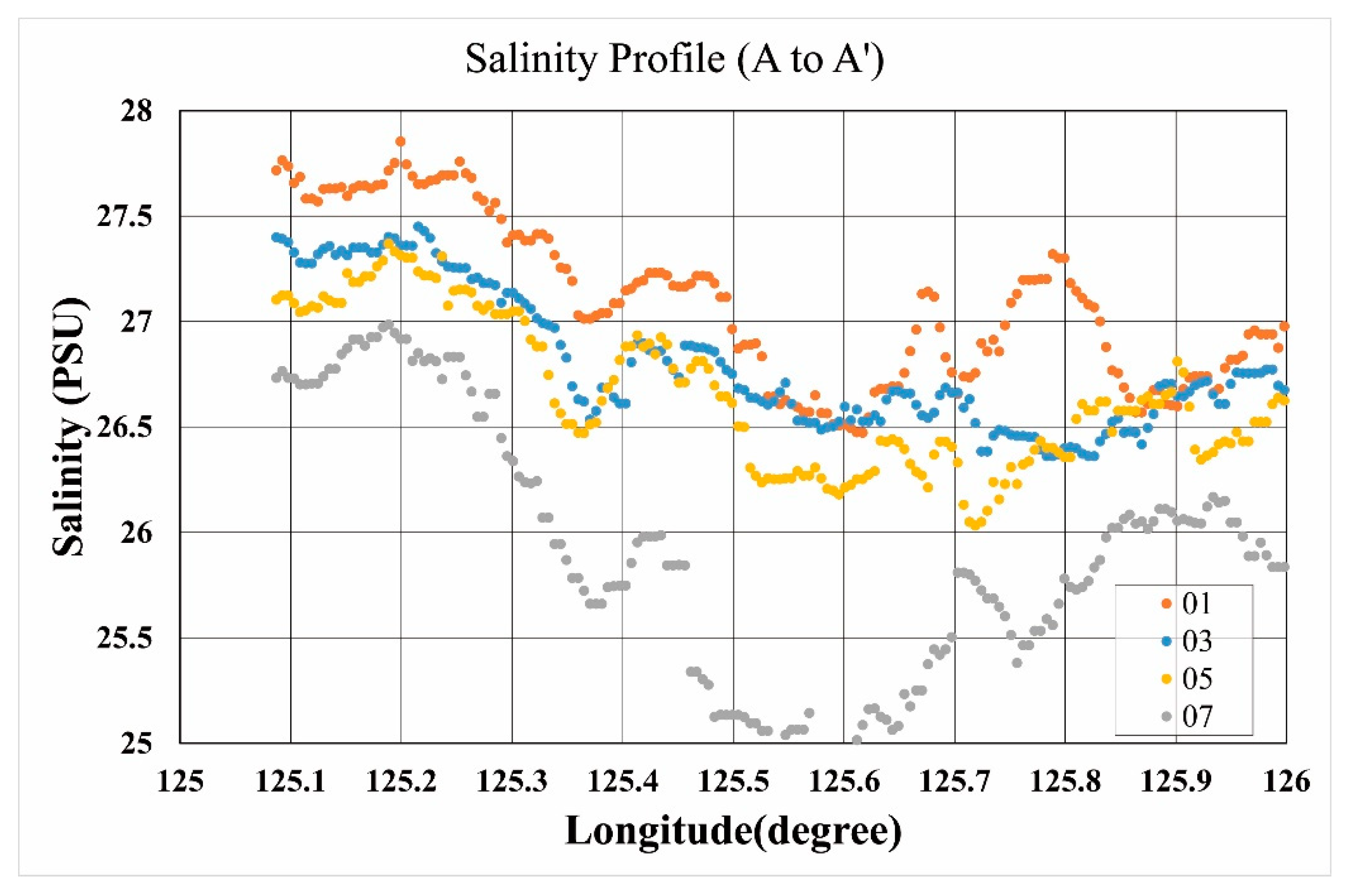
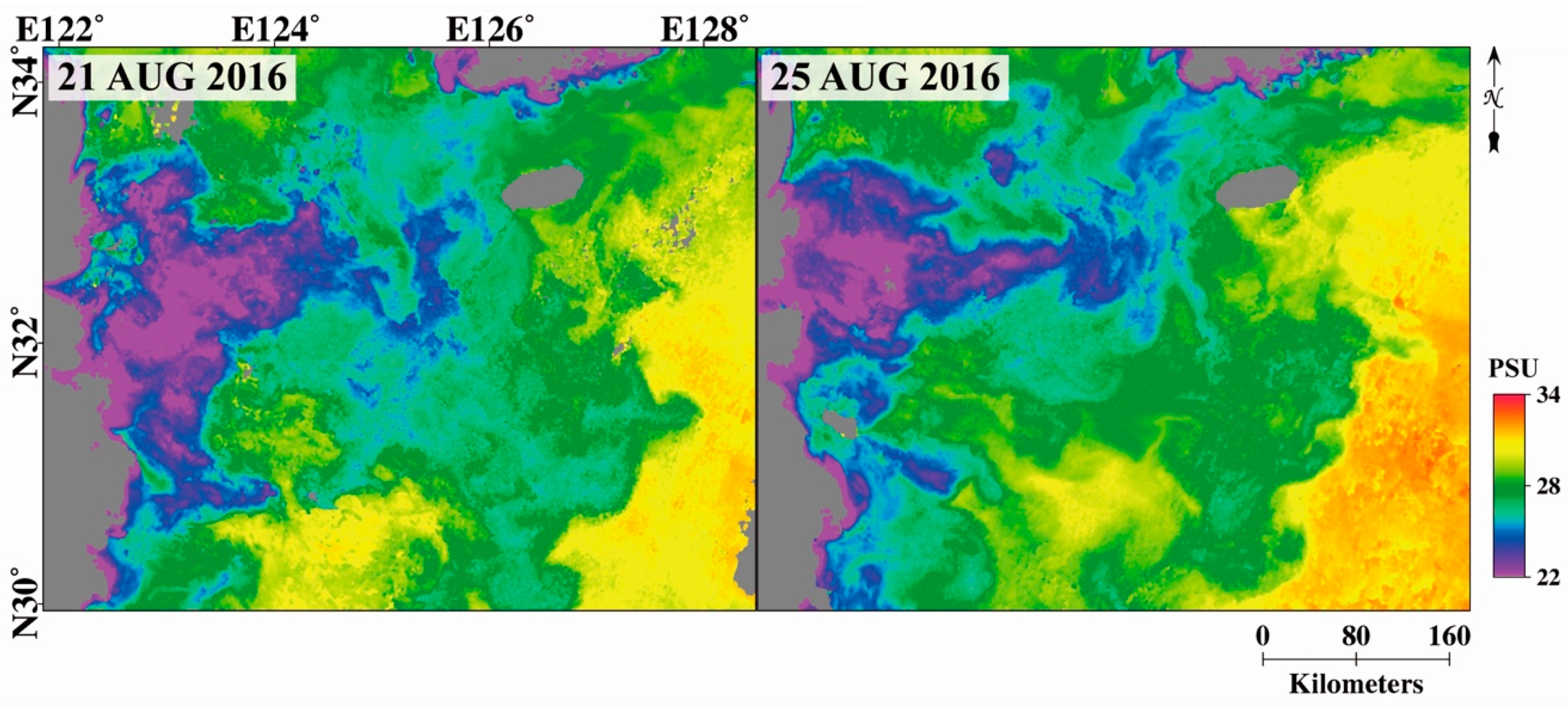
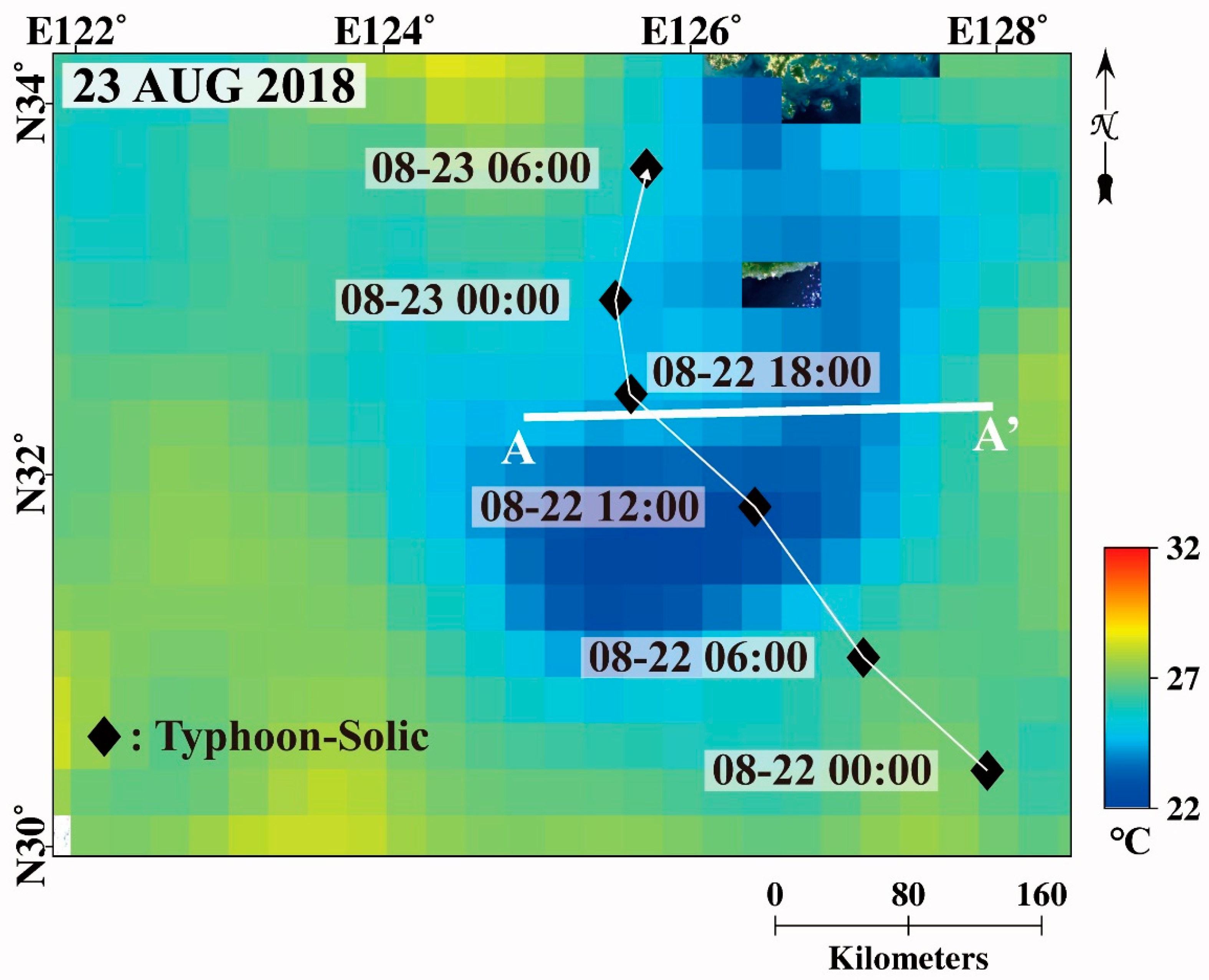


| Source | Time of Acquisition | Number of Measurements | Usage in This Study |
|---|---|---|---|
| Waveglider | August 2016 | 62 | Training set |
| 11 | Test set | ||
| NIFS | August 2012, 2013, 2016 | 7 | |
| R/V Ieodo [22] | August 2011 | 3 |
| Model | R2 | RMSE |
|---|---|---|
| Ahn’s model | 0.414 | 2.702 |
| Son’s model | 0.421 | 3.654 |
| This study | 0.803 | 0.914 |
Publisher’s Note: MDPI stays neutral with regard to jurisdictional claims in published maps and institutional affiliations. |
© 2021 by the authors. Licensee MDPI, Basel, Switzerland. This article is an open access article distributed under the terms and conditions of the Creative Commons Attribution (CC BY) license (https://creativecommons.org/licenses/by/4.0/).
Share and Cite
Choi, J.-K.; Son, Y.-B.; Park, M.-S.; Hwang, D.-J.; Ahn, J.-H.; Park, Y.-G. The Applicability of the Geostationary Ocean Color Imager to the Mapping of Sea Surface Salinity in the East China Sea. Remote Sens. 2021, 13, 2676. https://doi.org/10.3390/rs13142676
Choi J-K, Son Y-B, Park M-S, Hwang D-J, Ahn J-H, Park Y-G. The Applicability of the Geostationary Ocean Color Imager to the Mapping of Sea Surface Salinity in the East China Sea. Remote Sensing. 2021; 13(14):2676. https://doi.org/10.3390/rs13142676
Chicago/Turabian StyleChoi, Jong-Kuk, Young-Baek Son, Myung-Sook Park, Deuk-Jae Hwang, Jae-Hyun Ahn, and Young-Gyu Park. 2021. "The Applicability of the Geostationary Ocean Color Imager to the Mapping of Sea Surface Salinity in the East China Sea" Remote Sensing 13, no. 14: 2676. https://doi.org/10.3390/rs13142676







